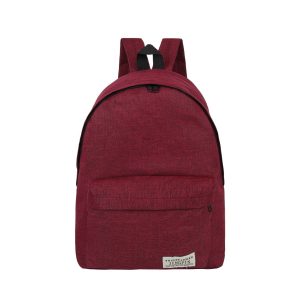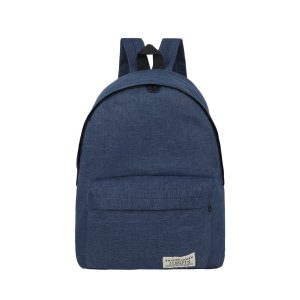Mountaineering bags are generally long and slender in order to travel through narrow terrain. The bag is divided into upper and lower layers, separated by a zipper sandwich in the middle, which is very convenient for taking and putting items. The sides and top of the backpack can be tied with tents and cushions, which virtually increases the size of the backpack. There is also an ice axe cover outside the backpack, which can be used to bind ice axes and snow poles. The most worth mentioning is the back structure of these backpacks. There is a lightweight aluminum alloy inner frame that supports the body. The shape of the back is designed according to ergonomic principles. The back is wide and thick, and the shape conforms to the physiological curve of the human body. The “S” shape design and chest strap prevent the shoulder straps from sliding to the sides, making backpackers feel very comfortable. Moreover, these backpacks have sturdy, wide and comfortable waistbands that can adjust the height of the shoulder straps. Users can easily adjust the strap to a height that suits them according to their own body. Generally speaking, the bottom of the backpack is above the hips, so that more than half of the weight of the backpack can be transferred to the waist, which greatly reduces the burden on the shoulders and reduces the damage to the shoulders for a long time. Long-term load-bearing.
The backpack has a capacity of more than 50 liters, which is suitable for long-distance travel and more professional adventure activities. For example, for long-distance trips or mountain expeditions in areas like Tibet, you should undoubtedly choose a large backpack with a capacity of more than 50 liters. If you need to camp in the field for some short- and medium-distance trips, you also need a large backpack, because only it can hold the tents, sleeping bags and sleeping mats needed for camping. Large backpacks can be divided into mountaineering bags and long-distance travel backpacks according to different uses.
Features of outdoor backpack:
1. Carrying system: The backpack carrying system consists of a back panel, shoulder straps, chest straps, and waist belts. The backboard is used to support the entire backpack. A good backpack can evenly distribute the gravity of the backpack. Shoulder straps, waist pads and chest straps play an important role in fixation. They must adjust. Different adjustments can be made according to the individual’s body shape to better fix it and reduce friction. In addition, the skin contact part of the shoulder strap and the inner side of the waist belt should be soft and elastic, which can effectively change the up and down friction of the upper shoulder belt or waist belt due to elastic vibration. The chest strap not only needs to be adjustable in length, but the fixed points on the chest strap should also be set as slide rails to facilitate adjustment to a personally comfortable position.
2. Fabric. Cycling bags generally use PU-coated nylon fabric (for example: PU-coated 450D polyester, 210D nylon), which has the functions of waterproof, dry-proof, abrasion-resistant, and tear-resistant. Whether the backpack is durable or not, the fabric is the main determinant. I don’t think everyone wants to encounter a situation where the backpack is broken when the donkey is abandoned halfway.
3. Designed with ventilation and sweat wicking system. When riding, the backpack is fully buckled on the back. Manufacturers of custom schoolbags for primary school students believe that if the back is not ventilated when riding, it will be quite uncomfortable for the wet sweat to cover the back. The backpack adds a mesh resin board to isolate the back from the body. The cycling bag uses a 3D breathable mesh design on the inner side of the shoulder strap and waist pad to give air a space to flow and effectively keep the parts in contact with the body dry.
4. Whether the loading system is reasonable. Backpacks usually consist of a main bag, a side bag and an accessory bag. Cycling bags will be relatively small, generally no more than 30L, generally 10L, 14L, 18L, 20L, 25L, etc., so through the design of each part of the backpack, you can better distribute items, and the capacity can be used reasonably, of course. The important thing is the convenience of access.


Ten articles before and after
Travel Bags – Exploring Italy – Junyuan Bags | Professional Bag Manufacturer
Children's schoolbag customization | Professional Bag Manufacturer
Top 10 Going To University Fashion Tips – Junyuan Bags | Professional Bag Manufacturer
Schoolbag customization guide | Professional Bag Manufacturer
Guide To Buying Backpacks – Junyuan Bags | Professional Bag Manufacturer
Best Every Day Backpack – Junyuan Bags | Professional Bag Manufacturer
Cleaning and maintenance of pupils' schoolbags | Professional Bag Manufacturer
Boutique Of The Week – The Times – Junyuan Bags | Professional Bag Manufacturer
Tips for using the backpack | Professional Bag Manufacturer
Street Art Tour Berlin, Germany – Junyuan Bags | Professional Bag Manufacturer




 Mobile/What's App/Wechat
Mobile/What's App/Wechat E-Mail
E-Mail ADD
ADD




